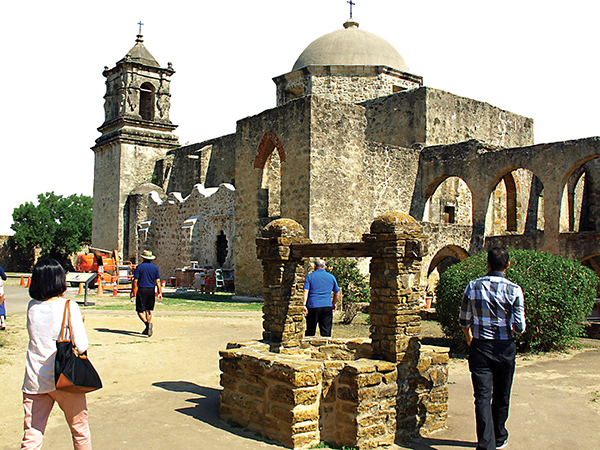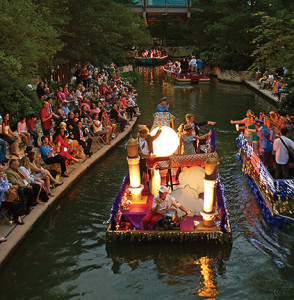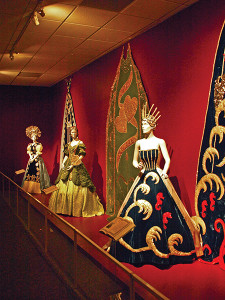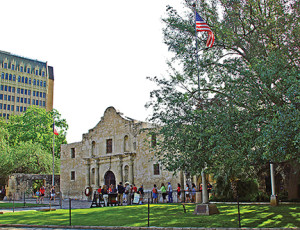San Antonio’s Grand Fiesta
Posted on February 28, 2015 by bob in Travel
by Andrea Gross, photos by Irv Green
It’s seven o’clock in the morning, and the San Antonio River Walk is almost empty. This is a stark contrast to last night when an
estimated 200,000 folks crowded the area, cheering and waving as 40 boats — each festooned in hot, bright colors and glittering lights — cruised down the meandering waterway that bisects the city’s downtown area.
People sat along the walkways that border the river, stood three deep on the arched bridges that span it, and applauded from the balconies of the luxury hotels that line it. After all, this was the Texas Cavaliers’ River Parade, one of the premier events of Fiesta® San Antonio, the city’s annual spring extravaganza.
But now, as my husband and I board an open-air boat for a 45-minute narrated breakfast cruise, there are only three boats on the river — two breakfast boats and one containing workers who are cleaning up the debris from the parade. We enjoy the relative quiet as our guide gives us an overview of the city’s history and Fiesta activities.
“Fiesta is a major part of San Antonio,” she says, as the boat passes La Villita, the site of Night in Old San Antonio (NIOSA), one of the myriad events that take place during the eleven-day party. There’s a pooch parade, a jazz band festival and a “fun run” for costumed mini-marathoners. There’s food, a coronation and Friday’s Battle of Flowers Parade. This event is so popular that the city literally shuts down for the day so that locals as well as visitors can watch as floats, bands and smiling children make their way through the city center. Finally, on Saturday night, there’s the Fiesta Flambeau Parade, reputedly the largest illuminated night parade in the world, replete with a jewel-bedecked queen and stately king, who reign over the festivities.
We’re not privy to the private parties where we could see the royal gowns up close, so we go to the Witte Museum for their annual exhibit that showcases past coronation gowns. I ask the curator how much an “average” gown costs. “Let’s just say they cost as much as a high-end luxury car,” she says.
In between attending Fiesta events, we explore San Antonio, beginning with its most famous attraction, the Alamo.
The Alamo began as a mission in 1700, but it’s most often remembered as a fortress, the place where Texas settlers chose certain death rather than surrendering to the overwhelming forces of Mexican General Antonio López de Santa Anna. A little over a month later, on April 21, 1836, other settlers, inspired by their compatriots’ bravery, defeated the Mexican army at the Battle of San Jacinto, thus paving the way for the establishment of the Republic of Texas and its eventual annexation to the
United States.
Today the Alamo is a museum, housing exhibits that are related to its days of glory. On the first Saturday of every month costumed actors roam the grounds, depicting life during the early days of Texas.
In addition to the Alamo, the Spaniards constructed four other missions, all of which still operate as functioning parishes and hold regular Sunday masses in both English and Spanish. The largest and most well known is Mission San José, which has been restored to its eighteenth century splendor and houses an excellent visitor center.
Two years ago the simplest way to reach these missions was by automobile, but now, due to a multi-year revitalization project, they’re also easily accessible by foot or bicycle. Mission Reach, an eight-mile southern extension of the San Antonio River Walk, winds through a semi-wilderness area filled with hiking and biking trails as well as portals to each of the missions that make up San Antonio National Historic Park.
A three-mile northern expansion of the River Walk, aptly named Museum Reach, leads through urban areas to a newly-restored area filled with trendy shops and restaurants as well as the San Antonio Museum of Art and the Witte Museum.
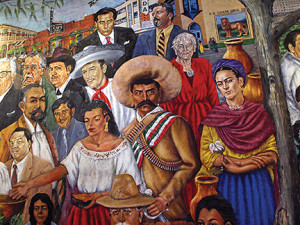
Mural at La Tierra restaurant in El Mercado depicts ordinary people interspersed with community leaders and historic figures.
Of course, in order to explore these areas, we have to fortify ourselves. We choose three restaurants that promise food that’s both traditional and tasty. We’re not disappointed. Guenther House, built in 1859 by the founder of Pioneer Flour Mills is as notable for its museum of millhouse memorabilia as its buttermilk biscuits. At Viola’s Ventanas we hear tales of the owner’s mother, whose homestyle cooking is featured in the restaurant, and at El Machito, which reputedly has the biggest grill in Texas, we happily gorge on a mixed platter of grilled cholesterol.
Chef Johnny Hernandez urges us to try one of his drinks, which are as Texas-sized as his grill. Why not? We lift our glasses and toast San Antonio, a city that knows how to party as it preserves its past and embraces its future.










